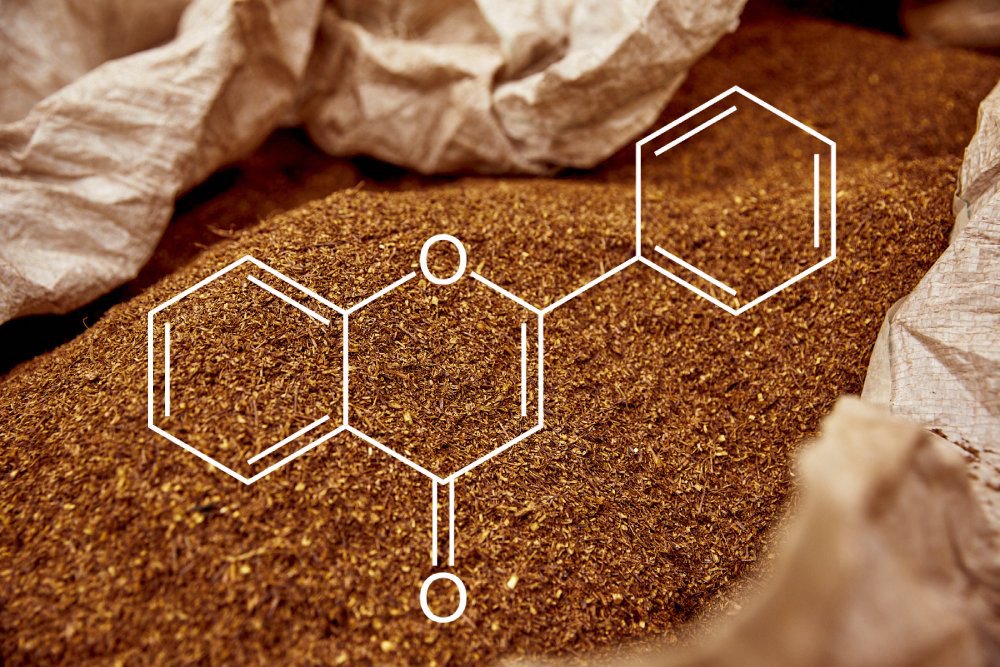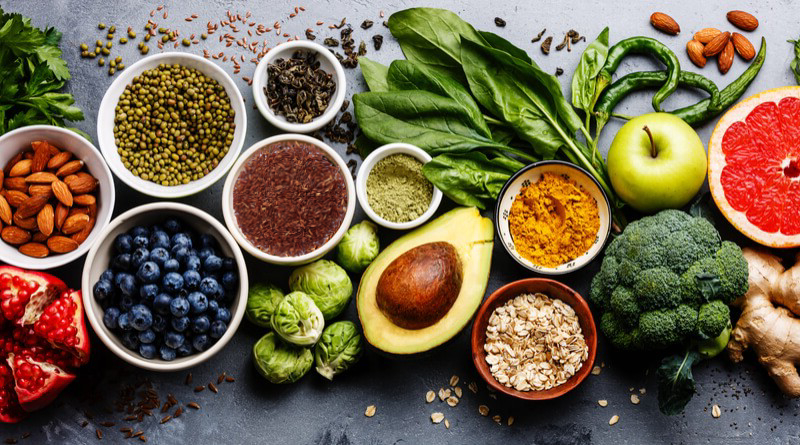As a herbal tisane whose popularity around the world continues to grow, interest in the reasons behind the health-giving properties of rooibos has increased. Driving this interest are a set of antioxidants known as flavonoids, each of which has a distinct characteristic, and some of which are relatively new to science.
In this article we take a closer look at the major and minor flavonoids in rooibos in order to provide an understanding of the specific properties of each and how they play a role in the benefits rooibos provides to consumers. By doing so, our article also seeks to outline the reasons why the flavonoids in rooibos are a point of interest and how this translates into tangible benefits for brands trading in the tea, beverage and health sectors.
At the outset, it is important to highlight that this is not a comprehensive investigation of all flavonoids in rooibos. Rather, this overview takes in those which are most prominent in terms of their relevance to tea brands and buyers as they relate to rooibos providing health-giving and functional benefits. As the full picture of the many compounds found in rooibos continues to grow, so other notable flavonoids may yet come to light.
What are flavonoids?
Flavonoids are bioactive compounds with antioxidant properties that contribute to various health benefits. They were once known as vitamin P, and are a large class of plant compounds found in deeply coloured fruits, vegetables, cocoa, wine – and in teas of all kinds, including herbal tisanes. In rooibos, these flavonoids consist of phenolic acids, and other compounds, each offering distinct physiological effects backed by scientific research.
Rooibos grows exclusively in the Cederberg region of South Africa, an area characterised by specific soil composition and climate conditions. These conditions, including the sandy, acidic soil and the hot, dry climate with low rainfall, create a challenging environment for the plant. In response to these stressors, rooibos plants produce a higher concentration of flavonoids as a defence mechanism against environmental threats.
As a result, rooibos features particularly high levels of flavonoids, the main polyphenols that fight oxidative stress from free radicals. Rooibos is considered unique due to the presence of aspalathin and aspalalinin, two flavonoids that are found exclusively in rooibos.
This natural abundance of flavonoids is what sets rooibos apart from other herbal teas, and is the reason for its unique flavour profile, which develops when the raw leaf and stalk are bruised and left to sweat. By doing so, rooibos producers create the conditions for the enzymatic oxidation reaction which gives rooibos its distinctive flavour profile, and also the rich amber-to-red colour it is so well known for.
For the purposes of this overview, we look into the various flavonoids in rooibos that contribute towards its flavour and health-boosting properties. By breaking these down into the major and minor flavonoids in rooibos (which are also called polyphenols), we’re able to define the properties of each in detail to get an understanding of the role these play.
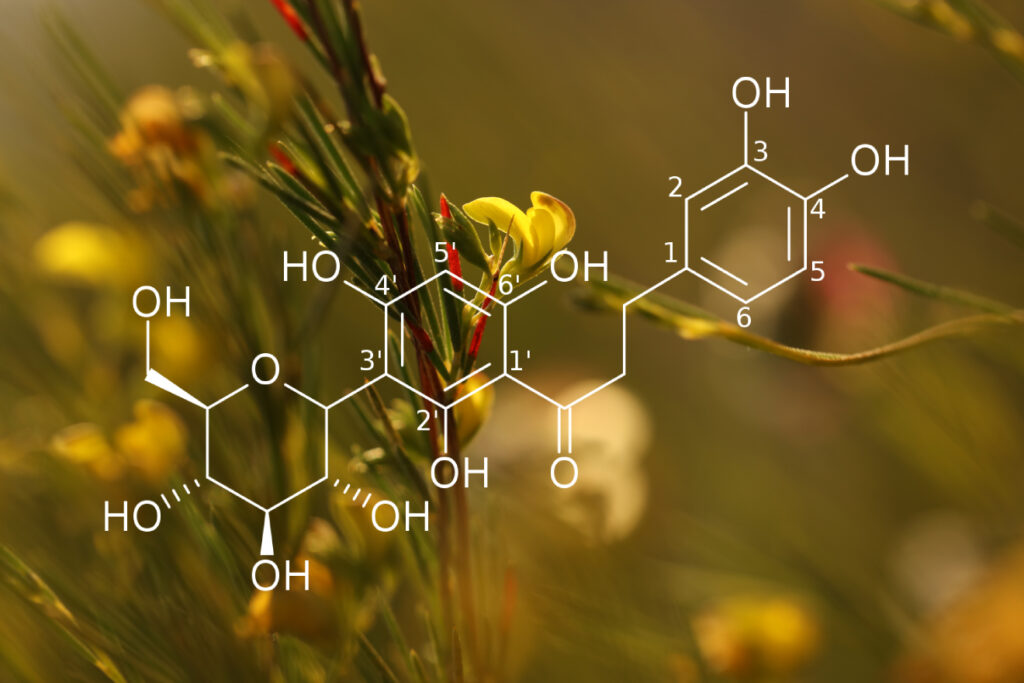
Major Flavonoids in Rooibos
Aspalathin – Rooibos’ Unique Antioxidant
Chief amongst the antioxidant compounds found in rooibos is aspalathin. This unique compound has to date been found in no other type of plant, and as a result its name is derived from the botanical name for rooibos, Aspalathus linearis. As the major flavonoids playing a significant role, aspalathin’s presence in red or ‘fermented’ rooibos tea provides a range of antioxidant benefits when consumed as a herbal tea.
As an antioxidant, aspalathin can play a role in helping neutralise harmful free radicals in the body 1. Free radicals can contribute to oxidative stress, which is associated with a variety of chronic diseases. In addition, aspalathin may have anti-inflammatory effects2 that potentially help to alleviate health conditions related to chronic inflammation such as heart disease and certain types of cancer.
Beyond these conditions, consuming rooibos tea and thus aspalathin can play a role in regulating blood sugar levels, which could be beneficial to those who suffer from, or are at risk of developing, diabetes. In this area, aspalathin is also thought to help improve lipid profiles and thus contribute to heart health.
Adding to the interest in aspalathin is the role it may play in weight management, through its action on metabolic processes. And if this were not enough to pique the interest of rooibos drinkers – and brands who operating in the functional beverages sector – everywhere, some research has shown that it may also have a positive impact on bone health3.
As a single antioxidant polyphenol in rooibos, it may seem that aspalathin is something of a multi-purpose compound that can yield a significant and wide range of benefits. Add the potential benefits of the many other flavonoids found in rooibos, and one can start to get a sense of how and why rooibos tea shows no signs of slowing down as a favourite herbal tea for a growing fanbase worldwide.
Aspalanin
Alongside aspalathin is aspalinin, another closely and structurally-related flavonoid which was isolated for the first time in 2006, and is also unique to rooibos. Though less research has been conducted into aspalanin’s properties as it is a relatively novel compound, research has shown that it may have anti-cancer properties7. Due to it being chemically similar to both aspalathin and nothofagin, it can be reasonably assumed that it plays much the same role in providing antioxidant benefits to rooibos tea consumers.
Nothofagin
This compound found in rooibos plays a similar role to that of aspalathin, in that it shows promise as far as fighting oxidative stress in the body and thus having a potentially beneficial effect on cardiovascular diseases4. As with aspalathin, nothofagin may play a role in the prevention or management of inflammatory conditions. What’s more, properties specific to nothofagin can assist in maintaining cognitive function and thus help protect against neurodegenerative diseases.
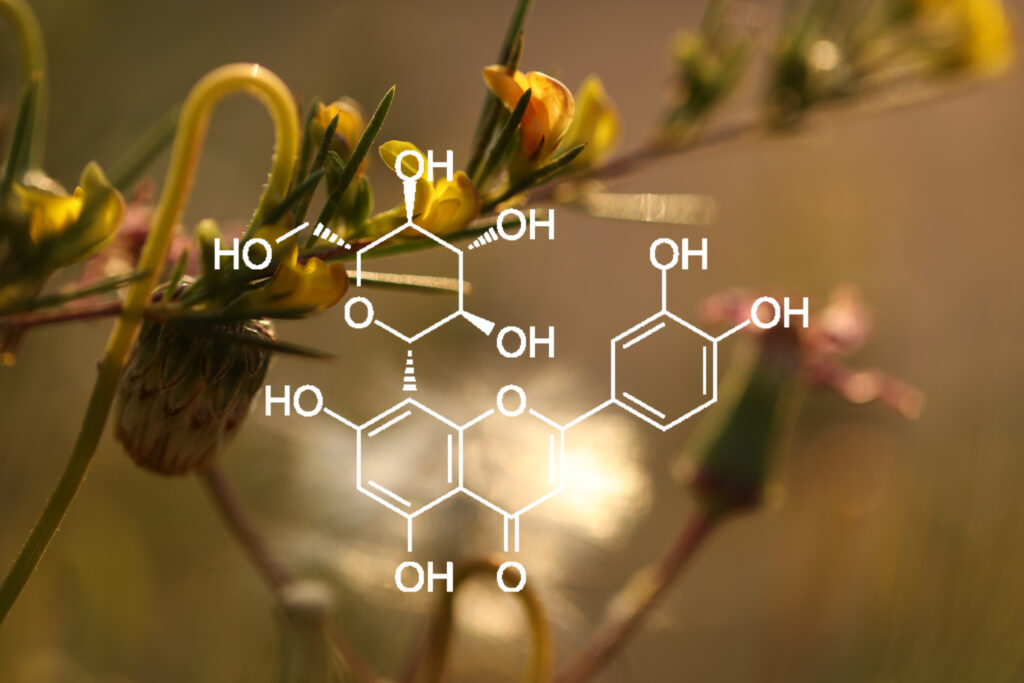
Minor Flavonoids in Rooibos
Orientin and iso-orientin
As with many of the flavonoids in rooibos, these closely linked compounds work in tandem with the other active components found in rooibos to provide a variety of benefits to the consumer. In particular, orientin and iso-orientin appear to alleviate digestive system discomfort5. Beyond this, studies have indicated that these two compounds also aid in building bone density6, particularly in women who suffer from osteoporosis.
Quercetin
Whilst perhaps less known than aspalathin, in some respects quercetin may be the superstar antioxidant in rooibos. With a demonstrated ability to block the immune cells responsible for triggering allergic reactions, quercetin has the potential to be effective at treating allergies8, without the negative side-effects sometimes associated with medications. As outlined in our Rooibos and Nasal Allergies article, the action of quercetin can play a role in alleviating symptoms for consumers who suffer from hayfever and other histamine-associated conditions.
The way in which quercetin acts is that it helps to prevent allergies from being triggered in the first place by blocking mast cells, which are responsible for the release of histamine, the chemical released by the immune system which triggers allergic responses.
Chrysoeriol
Though it is one of the least-known antioxidants in rooibos, research into the properties of chrysoeriol has yielded promising results. A powerful antioxidant in its own right, it has also been shown to be a good anti-inflammatory and also appears to have antimicrobial and antiviral action. Additionally, for sufferers of asthma, it has been demonstrated to possess bronchodilator effects9.
Vitexin and iso-vitexin
As with the other flavonoids found in rooibos, these two closely-related compounds have a broad antioxidant and anti-inflammatory profile, with more specific action that shows promise in a number of areas. These include potential cardioprotective benefits through vitexin’s effect on reducing blood pressure, improving blood vessel function and lowering cholesterol levels.10
Some studies have also suggested that vitexin may have neuroprotective effects that potentially offer protection to brain cells, making it relevant in the context of neurodegenerative diseases like Parkinson’s disease and Alzheimer’s. For the same reasons, there is also evidence that vitexin’s interaction with neurotransmitters in the brain means it may have anxiolytic and anti-depressant effects.11
Rutin
Rutin is a flavonoid found in varying concentrations in a range of plants, including rooibos. In general it has the same broad antioxidant properties as those listed here, and is thus also associated with having a variety of potential health benefits.
However, the action of rutin differs in two areas in that it also helps your body produce collagen and may enable the body’s uptake of vitamin C, providing a real boost by supporting vitamin C in the role it plays in the maintenance of healthy collagen and cartilage for the normal function of the skin, gums and the immune system.12
Luteolin
Another flavonoid present in rooibos, known for its antioxidant and anti-inflammatory properties. Since its discovery in 1829 by French chemist Michel Eugene Chevruel, it has been the source of a great deal of interest in the medical field as it has been reported to have a range of pharmacological properties. Among these, the anti-inflammatory, antioxidant, neuroprotective11, and analgesic12 effects are the ones that can be of significant value in pain management.
As an aside, Luteola means ‘yellow’ in Latin; it is thus luteolin that imparts some of the deep yellow that contributes to that end of the colour spectrum exhibited by brewed rooibos tea.
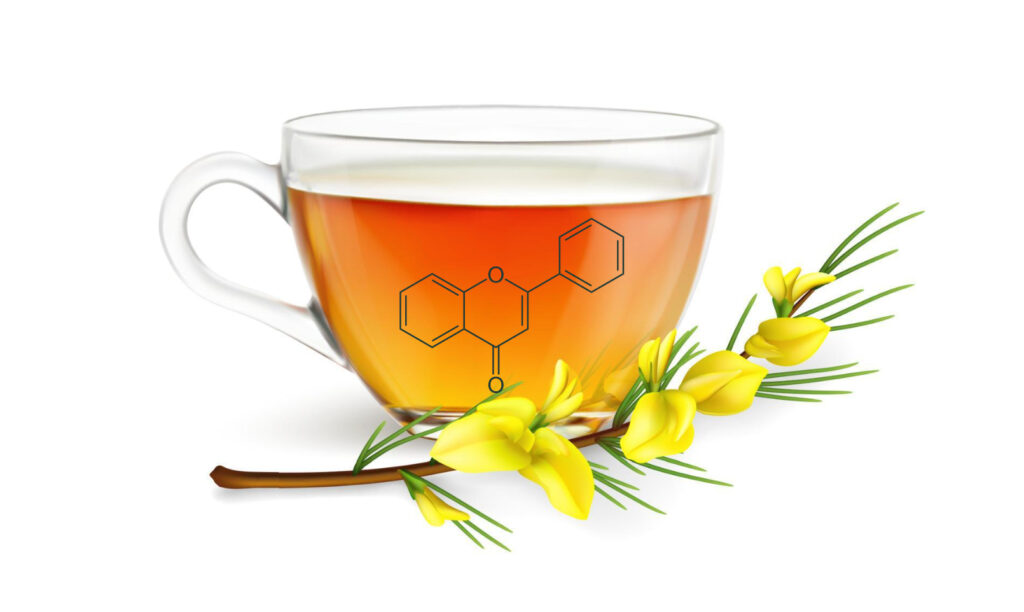
Rooibos as a Unique Flavonoid Powerhouse
For tea and beverage brands seeking to provide consumers with products that are appealing on both an organoleptic as well as functional level, rooibos offers an opportunity to satisfy a wide variety of consumer concerns and interests. It is for this reason that its popularity has grown over the last two decades, and why it continues to generate a significant amount of interest in the medical and scientific fields.
With the above range of flavonoids in rooibos having generated interest and thus research into their various properties, much is now known about how these provide benefit to consumers of rooibos tea. That said, much of the research in this area – in particular as it relates to compounds such as aspalinin – is relatively recent in nature.
What can be anticipated is that as consumer interest encourages tea and beverage brands, and thus nutritionists and dietary researchers, to dive deeper into the science of rooibos, new properties and potentially even new compounds may yet be over the horizon.
References:
1 – Rooibos (Aspalathus linearis) and its Major Flavonoids — Potential Against Oxidative Stress-Induced Conditions. Olawale R. Ajuwon, Jeanine L. Marnewick and Lester M. Davids, Basic Principles and Clinical Significance of Oxidative Stress, 2014
2 – Rooibos (Aspalathus linearis) facilitates an anti-inflammatory state, modulating IL-6 and IL-10 while not inhibiting the acute glucocorticoid response to a mild novel stressor in vivo. Smith, Swart, Journal Of Functional Foods, 2016
3 – Aspalathin from Aspalathus linearis (rooibos) reduces osteoclast activity and increases osteoblast activity in vitro. Sagar, Kasonga et al, Journal of Functional Foods, 2020
4 – Rooibos (Aspalathus linearis) and Honeybush (Cyclopia spp.): From Bush Teas to Potential Therapy for Cardiovascular Disease. Windvogel, Nutraceuticals – Past, Present and Future, 2018
5 – Isoorientin: A dietary flavone with the potential to ameliorate diverse metabolic complications. Ziqubu, Dludla, Joubert et al, Pharmacological Research Volume 158, 2020
6 – Rooibos flavonoids, orientin and luteolin, stimulate mineralization in human osteoblasts through the Wnt pathway. Nash, Sullivan, Peters et al, Molecular Nutrition & Food Research 59(3), 2014
7 – Protective properties of rooibos (Aspalathus linearis) flavonoids on the prevention of skin cancer. Gwashu, Stellenbosch University, 2016
8 – Quercetin as a potential anti-allergic drug: which perspectives? Chirumbolo, Iran J Allergy Asthma Immunol, 2011
9 – Selective bronchodilatory effect of Rooibos tea (Aspalathus linearis) and its flavonoid, chrysoeriol. Khan AU, Gilani, European Journal of Nutrition, 2006
10 – Vitexin exerts cardioprotective effect on chronic myocardial ischemia/reperfusion injury in rats via inhibiting myocardial apoptosis and lipid peroxidation. Xia, Xin, Junyang et al, American Journal of Translational Research, 2016
11 – Anti-oxidant, anti-inflammatory and anti-allergic activities of luteolin. Seelinger, Merfort, Schempp, Planta Med., 2008.
12 – Natural flavonoids as promising analgesic candidates: a systematic review. Xiao, Wang, Gui, et al, Chem Biodivers., 2016
This article is the latest in a series designed to provide tea industry buyers and brands with accessible reference material on rooibos tea. For further overviews of various aspects of the rooibos industry and rooibos as a herbal tisane, see these other articles here on our website:

